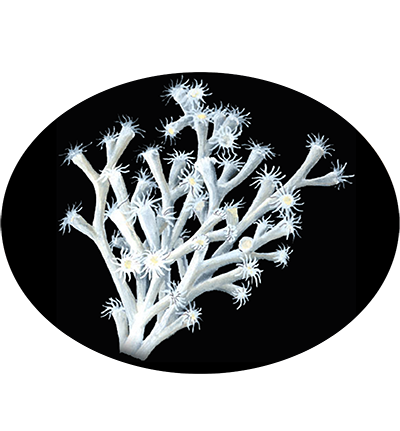
Lophelia pertusa is a cold-water coral that grows in the deep waters throughout the North Atlantic ocean, as well as parts of the Caribbean Sea and Alboran Sea. Although their reefs are home to a diverse community, the species is extremely slow growing and may be harmed by destructive fishing practices, or oil exploration and extraction. They does not contain zooxanthellae, the symbiotic algae which lives inside most tropical reef building corals. Lophelia lives at a temperature range from about 4–12 °C and at depths between 80 metres and over 3,000 metres, but most commonly at depths of 200–1,000 metres, where there is no sunlight.
Animalia (Kingdom); Cnidaria (Phylum); Anthozoa (Subphylum); Hexacorallia (Class); Scleractinia (Order); Vacatina (Suborder); Caryophylliidae (Family); Lophelia (Genus); Lophelia pertusa (Species)
Madrepora pertusa Linnaeus, 1758
1. Linnaeus C. Systema Naturae per regna tria naturae, secundum classes, ordines, genera, species; cum characteribus, differentiis, synonymis, locis[M]. apud JB Delamolliere, 1789. (Linnaeus et al., 1789)
Nova Scotia south to New Jersey. Depth range 39-2775 m
| Species | Phylum | Common Name | Ecosystem | Depth | Habitat | NCBI Taxonomy ID |
|---|---|---|---|---|---|---|
| Lophelia pertusa | Cnidaria | Desmophyllum pertusum, deep-sea coral | Hydrothermal vent | 50-3,600 | Savannah Banks site, off the southeastern coast of the continental USA, Atlantic Ocean (latitude 31.75420, longitude 79.19442) | 174260 |
| Genome Assembly | Genome Size | Assembly level | Released year | WGS accession | Submitter | BioProject | BUSCO completeness (%) | Scaffold/Contig N50 (kb) | GC content (%) | Repeat Rate (%) | Gene Number |
|---|---|---|---|---|---|---|---|---|---|---|---|
| Loph_1.0 | 556.9Mb | Scaffold | 2023 | JAPMOT01 | Lehigh University | PRJNA903949 | 88.90 | 1,600/438.6 | 39.4 | 57.37 | 37,484 |
| Title | Journal | Pubmed ID |
|---|---|---|
| Genome assembly of the deep-sea coral Lophelia pertusa | GigaByte | 36935863 |
| Gene ID | Description |
|---|---|
| OS493_031371-T1 | ACYL-COA DEHYDROGENASE |
| OS493_031374-T1 | SERINE/THREONINE-PROTEIN KINASE |
| OS493_031375-T1 | TRANSIENT RECEPTOR POTENTIAL CHANNEL |
| OS493_031376-T1 | - |
| OS493_031377-T1 | HEAT SHOCK PROTEIN 90 FAMILY MEMBER |
| OS493_031378-T1 | RNA POLYMERASE II-ASSOCIATED PROTEIN 1 |
| OS493_031381-T1 | COFILIN-RELATED |
| OS493_031382-T1 | PHOSPHATIDYLINOSITOL N-ACETYLGLUCOSAMINYLTRANSFERASE SUBUNIT H |
| OS493_031383-T1 | SESQUIPEDALIAN |
| OS493_031384-T1 | UBIQUITIN-ACTIVATING ENZYME E1 |
| OS493_031385-T1 | RNA POLYMERASE II-ASSOCIATED PROTEIN 1 |
| OS493_031386-T1 | RNA POLYMERASE II-ASSOCIATED PROTEIN 1 |
| OS493_031387-T1 | HEAT SHOCK PROTEIN 90 FAMILY MEMBER |
| OS493_031388-T1 | KH DOMAIN CONTAINING RNA BINDING PROTEIN |
| OS493_031389-T1 | DNA LIGASE |
| OS493_031390-T1 | CALCIUM HOMEOSTASIS MODULATOR PROTEIN |
| OS493_031391-T1 | VON WILLEBRAND FACTOR C AND EGF DOMAIN-CONTAINING PROTEIN |
| OS493_031392-T1 | - |
| OS493_031393-T1 | HISTAMINE RECEPTOR-RELATED G-PROTEIN COUPLED RECEPTOR |
| OS493_031394-T1 | EGF-LIKE DOMAIN-CONTAINING PROTEIN |

